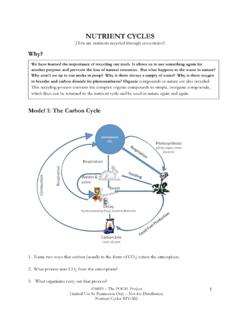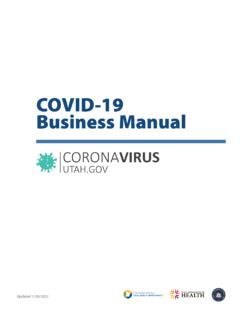Transcription of Simple summary of ventilation actions to mitigate the risk ...
1 Simple summary of ventilation actions to mitigate the risk of COVID-19 SAGE Environment and Modelling Group The potential for aerosol transmission (1) and the role of ventilation (2) and air cleaning (3) have been previously considered by the SAG Environmental and Modelling Group (EMG). This paper aims to summarise, in an accessible way, why ventilation is important and the key practical steps that could be taken to improve ventilation to mitigate the risk of SARS-CoV-2 transmission. While this paper focuses on ventilation it is important that other measures are maintained too, including distancing, hand hygiene, cleaning, wearing face coverings when appropriate and limiting social interactions.
2 Why is ventilation important? The virus that causes COVID-19 is spread through very small aerosols and droplets released in exhaled breath. There is evidence to show that in some cases these aerosols can be carried more than 2m in the air and could cause infection if they are inhaled (1). This is most likely to happen in indoor environments when the ventilation in a room is poor. If people spend sufficient longer periods of time in the room, the virus can build up in air and people can inhale enough of it to cause infection. The risk appears to increase when people are performing activities such as high intensity exercise, singing or loud talking that may cause them to breathe out more aerosols (1,4).
3 The risk is also likely to be higher in places where face coverings or masks are not worn, as these reduce the amount of virus that is emitted into the air (5,6). ventilation is also important for human health beyond COVID-19. Studies have shown that good ventilation is associated with improved health, better concentration, higher levels of satisfaction with an environment, lower rates of absence from schools and work, better quality of sleep and reduced exposure to a wide range of air pollutants (7-10). How are buildings ventilated? ventilation is the process of bringing in fresh air from outside and removing indoor air, which may contain pollutants including virus The method of ventilation will depend on the building.
4 Naturally ventilated buildings provide ventilation air without using any fans and rely on openings. A level of background ventilation is provided through small openings, typically trickle vents (small vents usually at the top of a window) and sometimes air bricks or grilles. These ensure there is always some airflow so it is important to make sure that the trickle vents are open. However, the flow rate through these can be rather low and cannot be increased, so it is therefore necessary to use other openings such as windows in order to increase ventilation .
5 These are most often operated manually, so will rely on occupants to open and close them. Mechanically ventilated buildings provide ventilation using fans to move air into and out of rooms. In small spaces and buildings these may be in the room, but larger buildings may use a network of ducts and fans to blow clean air into rooms and/or extract the stale air. This can vary from a Simple system such as a bathroom extract in a house, to a very complex and sophisticated system in a large commercial building. Small systems may be controlled by the occupants (using controls or switches in the space), but larger systems may be centrally or automatically controlled.
6 Mechanical ventilation has the advantage that, providing it is working correctly, it provides more consistent ventilation , but it may be more costly, requires energy to operate the system and needs to be properly maintained. Many buildings have a mixture of natural and mechanical ventilation , with different systems in different spaces. What is the ventilation rate? The ventilation rate refers to the volume of air that is provided to a room over a period of time, and is often stated in buildings guidance as recommended values. Some guidance recommends ventilation rates in terms of litres per second per person a value of 10 l/s/person is recommended in many guides as a suitable value for most commercial buildings (11).
7 The evidence so far suggests that COVID-19 transmission risk increases when the ventilation rate is very low; values in the range 1-3 l/s/person have been cited for a number of super-spreading events (2). Some documents state ventilation rates in terms of air changes per hour, which is a measure of the air flow rate relative to the room size. This measure can be useful to understand how quickly the ventilation removes contaminants from the air . A ventilation rate of 6 air changes per hour would mean that 6 times the volume of the room is provided every hour by the ventilation system.
8 However this doesn t mean that all the air is changed 6 times in the hour the new air mixes with the air that is already in the room causing dilution with time. At 6 air changes per hour, 95% of the contaminants in the air would be removed in 30 minutes. What measures can be taken in the home? Regular ventilation in the home is widely recognised as important to keep both people and the home healthy. Many people will find they have to balance ventilation with thermal comfort, especially in the winter months where the home relies on opening windows for ventilation .
9 For COVID-19, it is most important to ventilate spaces if someone in the home has the virus as this can help prevent transmission to other household members. Providing additional ventilation when there are visitors in the home and just after they leave is also likely to reduce risks in case they are infected. ventilation can be provided by making sure that any background ventilation devices are opened, and opening the windows will be the simplest method of increasing ventilation for most people. Simple actions such as ensuring background trickle vents are left open and avoiding blocking up vents can ensure there is constant background ventilation .
10 Wider openings will provide more air flow, but this doesn't mean that a window must be wide open all the time. ventilation rates through openings are determined by the wind speed and temperature difference between indoors and outdoors (12), and in colder weather opening the window a small amount can result in ventilation that is almost as effective as opening the window fully in the summer. If windows have openings at both high and low levels (such as sash windows) using just the top opening can be helpful in colder weather because incoming cold air will mix with warm room air and help temper cold draughts.


















